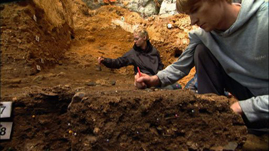Teachers' Domain - Digital Media for the Classroom and Professional Development
User: Preview

Source: The Human Spark: "Becoming Us"




Major funding for The Human Spark is provided by the National Science Foundation, and by the Alfred P. Sloan Foundation. Additional funding is provided by the John Templeton Foundation, the Cheryl and Philip Milstein Family, and The Winston Foundation.
ALAN ALDA (NARRATION) I’m back in the hills of southwestern France, heading for one of the classic Neanderthal archeological sites.
The question on my mind is this: We know that those of us who stayed behind in Africa somehow, some when, acquired the modern human mind, the Human Spark; our existence proves it. So then what was it about our Neanderthal cousins that prevented them from evolving the Spark? What made them different?
HAROLD DIBBLE Welcome to Roc de Marsal.
ALAN ALDA (NARRATION) The cave of Roc de Marsal sheltered Neanderthals from just over 80,000 years ago until the roof collapsed some 40,000 years ago. Still here, as the team patiently digs and brushes, is the debris of everyday life, including stone tools and the remains of the animals butchered by those tools. EXCAVATOR 1 Anybody got any shots?
EXCAVATOR 2 I’ve got one.
ALAN ALDA (NARRATION) As in most modern archeological excavations, the location of every item found is plotted in three dimensions with the help of a laser, and its details entered into a database. So far the team has logged some 17,000 stone tools and the same number of animal bones from just this small shelter. And from details like this, the archeologists are building a picture of Neanderthal life that seems strikingly similar to the life of their ancestors in Africa: for generation after generation, they stuck to the same way of doing things.
HAROLD DIBBLE When you look at the enormity of time represented in these early industries, that is, the times of Neanderthal, it’s mind-blowing. I mean, hundreds of thousands of years. And you see the same sorts of patterns repeated over and over and over again. You don’t see a clear evolution of traits over and over again.
ALAN ALDA So they weren’t very innovative?
HAROLD DIBBLE Yeah, in a sense, in a sense. But the thing is too, I would look at it more as they were very adept at adapting what they do have to the local situations, right?
SHANNON MCPHERRON I would say they were flexible but not innovative. They had their tool kit, they had their solutions and they picked from that tool kit over and over and over for hundreds of thousands of years, from that, basically, the same tool kit.
ALAN ALDA (NARRATION) Just as we had with the hand axe from Kenya, we asked John Shea to make the basic tool from the Neanderthal tool kit. Remarkably, the two are almost identical.
The technique for making it became more sophisticated – Neanderthals started using a bone or antler hammer to make the edges thinner and sharper – but the tool itself changed very little in the 1.6 million years since the common ancestor we shared with Neanderthals first figured out how to make it.
Even after arriving in Europe, Neanderthals stuck to the old ways. ALAN ALDA It’s still striking, for me, to try to comprehend that they went so many thousands of years pretty much not changing the way they did things.
SHANNON MCPHERRON I know.
ALAN ALDA How many generations would that have been?
HAROLD DIBBLE 40 thousand years, if you want to figure that’s the occupation of this cave, would be two thousand generations.
ALAN ALDA Two thousand generations!
HAROLD DIBBLE Two thousand great...
ALAN ALDA Two thousand great grandfathers and grandmothers...that’s amazing!
HAROLD DIBBLE It really is...
ALAN ALDA And yet, that’s a long time that they survived.
 Loading Standards
Loading Standards